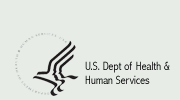

Chemical Waste
 Chemical
waste includes nonradioactive chemical solids, liquids, or other waste
types contaminated with hazardous chemicals. The chemical waste management
program at the NIH Bethesda Campus emphasizes reduction of chemical waste
generation through process improvements wherever possible, and proper
management of chemical waste streams that are generated. NIH has undergone
several successful chemical waste reduction efforts. Examples include
voluntary retrofilling or replacement of all high voltage transformers
containing polychlorinated biphenyls (PCBs) and an ongoing program to
minimize generation of radioactive and mixed wastes (radioactive chemical
wastes) from research laboratories. As a result, generation of mixed wastes
by NIH has been reduced by over 99% relative to the mid 1990s. More recently,
the "Mad as a Hatter Campaign" targeted improvement awareness
of mercury hazards and eliminated unnecessary uses of mercury at all NIH
facilities. In response to the mandate of Executive Order 13148 and NIH's
waste reduction philosophy, initiatives are planned to identify and target
additional chemical waste streams for further reduction efforts. Chemical
waste includes nonradioactive chemical solids, liquids, or other waste
types contaminated with hazardous chemicals. The chemical waste management
program at the NIH Bethesda Campus emphasizes reduction of chemical waste
generation through process improvements wherever possible, and proper
management of chemical waste streams that are generated. NIH has undergone
several successful chemical waste reduction efforts. Examples include
voluntary retrofilling or replacement of all high voltage transformers
containing polychlorinated biphenyls (PCBs) and an ongoing program to
minimize generation of radioactive and mixed wastes (radioactive chemical
wastes) from research laboratories. As a result, generation of mixed wastes
by NIH has been reduced by over 99% relative to the mid 1990s. More recently,
the "Mad as a Hatter Campaign" targeted improvement awareness
of mercury hazards and eliminated unnecessary uses of mercury at all NIH
facilities. In response to the mandate of Executive Order 13148 and NIH's
waste reduction philosophy, initiatives are planned to identify and target
additional chemical waste streams for further reduction efforts.
Various offices interact in the management of NIH's chemical waste
program. The Division of Occupational Health and Safety (DOHS) identifies
potentially hazardous situations in work areas and recommends appropriate
control measures. DOHS also reviews safety protocols for work involving
certain hazardous chemicals to ensure that the proposed activities are
conducted by trained personnel using the proper safety equipment. The
Division of Environmental Protection (DEP) provides services related to
the treatment and disposal of chemical waste. The NIH Occupational Medical
Service offers a comprehensive occupational medical care program to NIH
employees, including providing emergency medical treatment in the event
of an acute chemical exposure and providing periodic medical surveillance.
If you would like more information about this program, please contact
Charlyn Lee
 Chemical Waste Objectives
Chemical Waste Objectives
 How NIH Meets Chemical Waste Objectives coming soon
How NIH Meets Chemical Waste Objectives coming soon
 Chemical Waste Environmental Management Program (EMP)
Chemical Waste Environmental Management Program (EMP)
Tracking Our Chemical Waste Management Progress
Related Links
|






 Chemical
waste includes nonradioactive chemical solids, liquids, or other waste
types contaminated with hazardous chemicals. The chemical waste management
program at the NIH Bethesda Campus emphasizes reduction of chemical waste
generation through process improvements wherever possible, and proper
management of chemical waste streams that are generated. NIH has undergone
several successful chemical waste reduction efforts. Examples include
voluntary retrofilling or replacement of all high voltage transformers
containing polychlorinated biphenyls (PCBs) and an ongoing program to
minimize generation of radioactive and mixed wastes (radioactive chemical
wastes) from research laboratories. As a result, generation of mixed wastes
by NIH has been reduced by over 99% relative to the mid 1990s. More recently,
the "Mad as a Hatter Campaign" targeted improvement awareness
of mercury hazards and eliminated unnecessary uses of mercury at all NIH
facilities. In response to the mandate of Executive Order 13148 and NIH's
waste reduction philosophy, initiatives are planned to identify and target
additional chemical waste streams for further reduction efforts.
Chemical
waste includes nonradioactive chemical solids, liquids, or other waste
types contaminated with hazardous chemicals. The chemical waste management
program at the NIH Bethesda Campus emphasizes reduction of chemical waste
generation through process improvements wherever possible, and proper
management of chemical waste streams that are generated. NIH has undergone
several successful chemical waste reduction efforts. Examples include
voluntary retrofilling or replacement of all high voltage transformers
containing polychlorinated biphenyls (PCBs) and an ongoing program to
minimize generation of radioactive and mixed wastes (radioactive chemical
wastes) from research laboratories. As a result, generation of mixed wastes
by NIH has been reduced by over 99% relative to the mid 1990s. More recently,
the "Mad as a Hatter Campaign" targeted improvement awareness
of mercury hazards and eliminated unnecessary uses of mercury at all NIH
facilities. In response to the mandate of Executive Order 13148 and NIH's
waste reduction philosophy, initiatives are planned to identify and target
additional chemical waste streams for further reduction efforts.